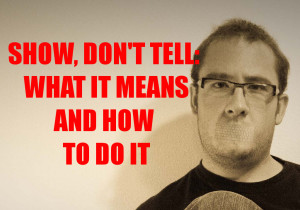Background exposition. When your characters have enough history to fill another whole book, but you’re not ready to write that book yet (or ever).
It usually looks like this (notice the proliferation of past perfect tense):
She had been living alone since her husband, Tom, left. He hadn’t stayed around long after their baby died. It had been a long, intensive labor, and the little girl, born a full month early, hadn’t survived.
Or this:
I had been the youngest ever accepted into the Academy, and the quickest ever to graduate. Since then, I had sought out every acclaimed blade-wielder in the five kingdoms, and defeated them all. I had come to this city for one reason only; to challenge the last.
Why is this a problem?
Because real people don’t go around summarizing their own histories in their heads. So when fictional people do it, it ruins the suspension of disbelief.
Now, let’s find a way to show.
We have to seamlessly work all the same details into an actual scene. Into action. Into dialogue. The trick is to plant clues for our readers. Let’s start with our first example:
It didn’t matter if no one else was around to appreciate it. It was Christmas Eve, for heaven’s sake; the house shouldn’t be completely devoid of twinkle lights and fake greenery. Maggie yanked down the attic stairs and ascended them with a flashlight.
She found the tree right away; it was still in the box it came in. Nothing else was labeled, of course. Waste of effort, Tom would say every year, I’ll remember which ones are which.
“Fat lot of good that does me now, Tom,” she said aloud. She pulled up the flaps of the next closest box.
And stopped breathing.
A tiny pink dress stared up at her from atop a pile of tiny hats and tiny pairs of overalls and tiny white socks fringed with lace. She blinked. Tom must have put it up here. After he said he’d get rid of it all. She remembered, because she’d specifically asked him to.
What else would I do with it? he’d snapped; I don’t know why we bought all this crap so early on, anyway.
Early. Everything had been too early. The clothes. The morning. The baby.
Maggie bowed her head and sobbed into the cardboard.
A little bit of past perfect tense sneaks in there, but it’s much more organic to the scene.
See how we use Maggie’s present to illustrate her past? See how we don’t actually come right out and say anything, but it’s all evident in what she’s doing and what she’s thinking? We never say Tom was her husband, but our readers see that they had a house together, celebrated holidays together, and at some point thought they were going to have a child. We never mention that the baby died, but from the baby’s absence, the boxed-up baby clothes, the couple’s angry conversation, the “early” tie-in, and Maggie’s tears, our readers get the message.
To sum up:
- Show the past by telling the present consequences
- Give your reader clues, not facts
- Work those clues into the action and dialogue
Stay tuned: next week we’ll do a “showy” version of the second example.
—
Read last week’s post on how to “Show, Don’t Tell” with description.





